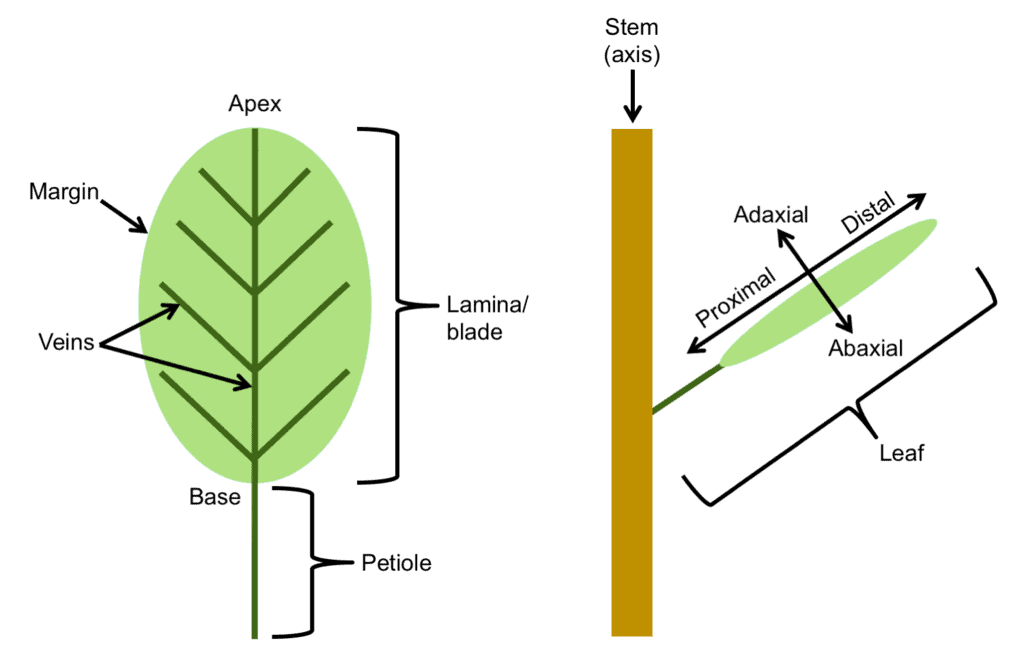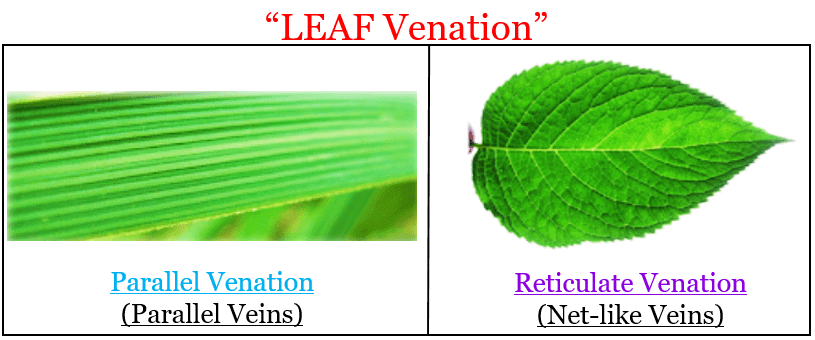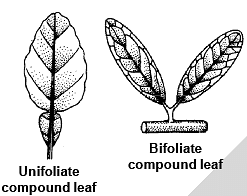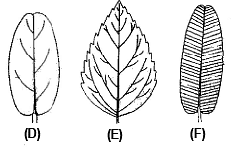The Leaf: Types of Leaves, Phyllotaxy, Venation & Modifications of Leaves | Science for ACT PDF Download
| Table of contents |

|
| What is Leaf? |

|
| Functions of Leaves |

|
| Phyllotaxy |

|
| Venation |

|
| Modification of Leaves: |

|
What is Leaf?
 Structure of Leaf
Structure of Leaf
The leaves develop from the nodes. Their main function is photosynthesis and food making auxiliary buds are found in its axil. Leaves originate from shoot apical meristems and are arranged in an acropetal order.
Leaf is divided into 3 main parts:
(1) Leaf base - The part of leaf attached to stem
(2) Petiole - The part of leaf connecting the lamina with the branch or stem, petiolated or stalked leaves are known as petiolate and when petiole or stalk is absent then leaves are called sessile. In Eichhornia petiole swells and in citrus it is winged.
(3) Lamina (Leaf blade ) - It is a broad and flattened part of leaf. Its main functions are photosynthesis and transpiration.
Stipules
Leaves of some plants have lateral appendages on either side of leaf base, known as stipules.
If stipules are present in leaf it is called stipulated leaf, if it is absent then leaf is called ex-stipulated.
Stipules are of various types:
1 . Free lateral - They are independently present on both sides of leaf base. Eg. Hibiscus rosasinensis (China rose).
2 . Interpetioler - When two leaves are meet oppositely at the node then two nearest stipules of adjacent leaf joint with each other. In this way only two stipules of two leaves are found in place of four Eg. Ixora .
3 . Intrapetioler - In this type both stipules of a single leaf join with each other to form a single stipule.Eg :– Gardenia


4 . Foliaceous - These type of stipules form a leaf like structure. Eg . :– Pea
5 . Scaly - Stipules are dry , small and paper like. E g :– Desmodium
6 . Spiny - Stipules modified into spines. Eg. Zizyphus (Ber)
7 . Ochrea te - When both stipules of leaf combine together and form a tube-like structure, it is called ochreate. Eg. polygonum
8 . Adnate - Both stipules are joint with petiole. Eg. Rose.
9. Tendrillar - Stipules are modified into tendrils like structure. Eg. Smilax


Types of Leaves
1. Foliage leaf - They are usually green coloured and their main function is photosynthesis.
2. Cotyledonary leaf - This leaf comes out during germination and helps in nutrition until the first leaf is not formed.
3. Scale leaf - Such leaves are usually dry membrane like and they cannot perform photosynthesis.



4. Bract - Bract are the leaves which contain flower in their axil.
5. Bracteole - These are leaf like structure found on pedicel.
6. Floral leaf - Sepals, petals , stamen and carpel are found in flower which are included in this type of leaf.
Note : Perianth : In some flowers, Calyx and Corolla are not distinct and are termed as Perianth, and unit of perianth is called tepal. Eg. Lily

Duration of Leaf
1. Persistent/ Evergreen - Leaves of such plants are found in all season and do not (fall) shed in a combined way. Eg. Pine, Saracaindica , Datepalm.
2. Deciduous - All leaves of such plants shed at the same time Eg. Azadirachta, Ficus
3. Caducous - Leaves shed as the bud formation takes place. Eg :– Rose
NOTE :
1. Cauline leaves - When the leaves are found on node of the stem, then they are called cauline leaves.
2. Ramal leaves - When leaves are found on branches, then they are called ramal leaves.
3. Radical leaves - During favourable season ,leaves develop from the nodes of underground stem and seem that they are developing from roots. This type of leaves are known as radical leaves.
Functions of Leaves
The leaves perform the following functions:
1. Photosynthesis: Photosynthesis is the primary function of leaves. They convert carbon dioxide, water, and UV light into glucose through the process of photosynthesis.
2. Transpiration: Transpiration is the removal of excess water from the plants into the atmosphere. This occurs by the opening of stomata present in the leaves.
3. Guttation: Removal of excess water from the xylem at the edges of the leaves when the stomata are closed is known as guttation.
4. Storage: Leaves are a site of photosynthesis. Therefore, they store water and nutrients. The succulent and thick leaves particularly adapt to water storage.
5. Defence: Some leaves are modified into spines to protect them from being damaged or eaten by animals. For eg., Opuntia.
Phyllotaxy
The patterns of arrangement of leaves on the stem are called Phyllotaxy. Plants show three types of phyllotaxy- alternate, opposite and whorled types of phyllotaxy.
- When only a single leaf develops at each node alternatively, it is an alternate type of phyllotaxy.E.g. China rose.
- When a pair of leaves develops at each node opposite to each other, it is called opposite phyllotaxy.E.g. Guava plants.
- When more than two leaves develop at the nodes to form a whorl of leaves, it is called whorled phyllotaxy. E.g. Alstonia.
Venation
The arrangement of veins and veinlets in leaves (Lamina) is known as venation. It is of 2 - types
(1) Reticulate. It is found in dicots. Exception – Calophyllum (It has parallel venation)
(2) Parallel. It is found in monocots. Exception – Smilax (It has reticulate venation)

1. Reticulate Venation
In this type of venation many veins are divided into various branches (veinlets) and form a net-like structure.
Reticulate venation is of two types:
(a) Unicostate or pinnate - This type of venation is having only one principal vein or midrib that give off many lateral veins which proceed toward margin and apex of lamina of the leaf and form a network. Eg. :– Mango, Guava, Peepal.
(b) Multicostate or palmate - In this type of venation many principal veins arising from the tip of petiole and proceed upward, this is again of two types –
(i) Multicostate divergent - Many principal veins arising from the tip of petiole diverge from one another towards the margin of leaf blade eg. Cotton, Castor, Cucurbita.
(ii) Multicostate convergent - Many principal veins arising from the tip of petiole. At the base of leaf they are closely arranged but diverge from one another in middle part and converge towards the apex of leaf. Eg. :– Camphor, Zizyphus , Tejpat, China rose , Plum.



Parallel Venation
In this type of venation, all veins run parallel to each other and they do not form network.
They are of 2 types –
( 1 ) Unicostate or pinnate : This type of pattern having only one principal vein, that gives off many lateral veins, which proceed toward the margin of leaf blade in a parallel manner but they do not have veinlets. Eg. Banana, Ginger, Canna.
( 2 ) Multicostate or palmate : Having many principal veins arising from the tip of the petiole and proceeding upwards.
(a) Multicostate divergent : Many principal veins arising from the tip of petiole and diverge toward the margin of leaf. They do not divide into veinlets and do not form network. Eg. :– Coconut, Fan palm.
(b) Multicostate convergent : Many principal veins arising from the tip of petiole run in a curved manner in lamina and converge towards the apex of leaf blades. Eg. :– Wheat, grass, sugar–cane, Bamboo



Modification of Leaves:
When leaf is modified in different structure. It is called modification of leaves.
(1) Leaf tendril - In this, whole leaf is modified into a wire-like structure which is called leaf tendril Eg. Lathyrus aphaca (wild pea)
(2) Leaf spine - Leaves or any part of leaflet are modified into pointed spine. Eg. Opuntia , Aloe,Argemone .
(3) Leaf scale - In this leaves become thin, dry and form a membrane or paper-like structure and serve to protect axillary buds as in Ficus and Tamarix , Ruscus or store food and water as in onion.
(4) Leaf pitcher - Leaves o f some plants are modified to pitcher shape . Eg . Nepen thes, Dishidia
(5) Leaf bladder - In some plant, leaves are modified into bladder like structure eg. Utricularia
(6) Leaf Hooks - In some plants terminal leaflets are modified into curved hooks for helping the plant in climbing .Eg. Ca t' s nail (Bignonia unguis - cati ).
(7) Phyllode - In it petiole becomes flat structure and function as normal leaf. Eg. Australian acacia
(8) Leaflet tendril - When leaflet is modified into tendril-like structure than it is called leaflet tendril. Eg . :– Pisumsativum (Garden Pea), Lathyrus odoratus (sweet pea).
Note : Dionaea (Venus flytrap) is insectivorous plant and they also have modified leaves.


Simple and Compound Leaf
( 1 ) Simple Leaf : A leaf which may be incised to any depth, but not up to the midrib or petiole then this type of leaf called simple leaf.
( 2 ) Compound leaf : A leaf in which the leaf blade is incised up to the midrib or petiole, thus dividing it into several small parts, known as leaf lets.
It has two types :–
(A) Pinnately compound leaf : In this type of leaf mid rib is known as rachis. Leaf lets are arranged on both sides of rachis. Eg. Neem It is of four types
(i) Unipinnate : In this type of leaf division occurs only once and leaf lets are directly attached on both sides of rach is. If the number of leaflet is even , then leaf is known as paripinnate. Eg . : Cassia fistula, Sesbania If the number of leaflet is odd, it is known as imparipinnate. Eg. :–Rose, Neem
(ii) Bipinna te : A twice pinnate compound leaf. Eg . :– Acacia , Gulmohar, Mimosa
(iii) Tripinnate : A thrice pinnate compound leaf. Eg . Moringa
(iv) Decompound : A compound leaf, which is more than thrice pinnate. Eg :– Carrot, Coriander


(B) Palmate compound : In this type incision of leaf are directed from leaf margin to apex of petiole and all leaflets are attached on the upper end of petiole. Eg. Silkcotton.
It is of following types :
(i) Unifoliate : When single leaflet is found. Eg . :– Lemon
(ii) Bifoliate : W hen two leaflets are present. Eg . :– Bauhinia , Regnelidium
(iii) Trifoliate : W hen three leaflets are attached . Eg. :– Oxalis, Aegle.
(iv) Tetrafoliate : When four leaflets are attached to the petiole. Eg . :– Marsilea
(v) Multifoliate : When more than four leaflet are found, then leaf is called multifoliate palmate compound leaf. Eg. Silkcotton.




Shape of Lamina:
1. Acicular :– Lamina is long and pointed, like a needle. Eg. Pine .
2. Lanceolate :– In this type lamina is pointed or narrower at the ends while broader in the middle. Eg. Bamboo, Nerium
3. Linear :– The lamina is long and narrow having parallel margins. Eg. Grass
4. Ovate :– In this type lamina is egg–shaped having broad base with slight narrow top. Eg. Ocimum , Banyan , China rose
5. Cordate :– Its shape is like a heart. Eg. Betel.
6. Oblong :– Long and broad lamina. Eg. Banana.
7. Sagittate : – The lamina is triangular in shape. Eg. Sagittaria .
8. Spathulate :– The lamina is broad spoon shaped. Eg. Calendula .
9. Orbicular or Rotund :– In this type the lamina is spherical. Eg. Lotus.
10. Elliptic al or Oval : In this type, the middle part of lamina is broad while the ends are narrow and oval. E g. Guava, Jamun
11. Oblique:– In this type, midrib divides lamina into two unequal halves. Eg. Begonia , Neem.
Shapes of lamina :

(A) Acicular, (B) Linear, (C) Lanceolate,

(D) Elliptical, (E) Ovate, (F) Oblong

(G) Rotund, (H) Cordate, (I) Sagittate, (J) Oblique (K) Spathulate
|
486 videos|517 docs|337 tests
|
FAQs on The Leaf: Types of Leaves, Phyllotaxy, Venation & Modifications of Leaves - Science for ACT
| 1. What is the structure and function of a leaf? |  |
| 2. What is phyllotaxy? |  |
| 3. What is venation in leaves? |  |
| 4. What are the modifications of leaves? |  |
| 5. How do leaves contribute to the process of photosynthesis? |  |

|
Explore Courses for ACT exam
|

|


















